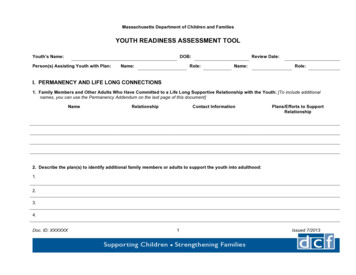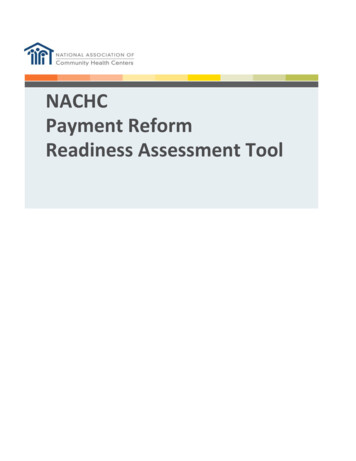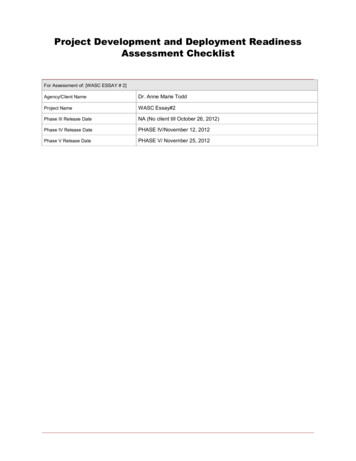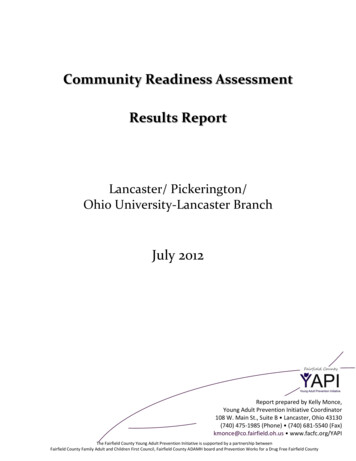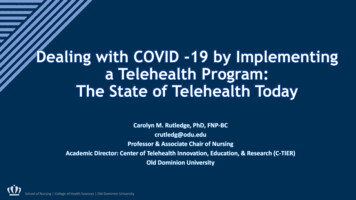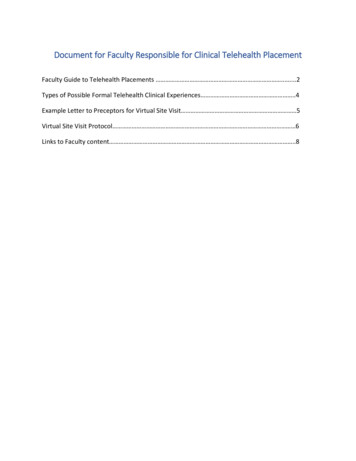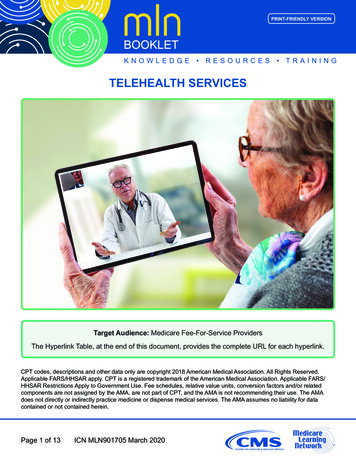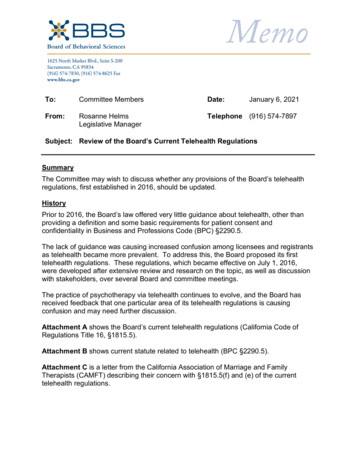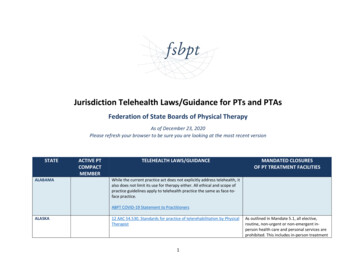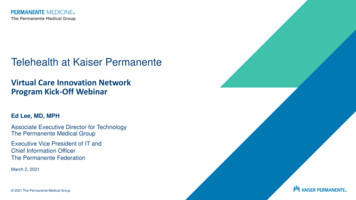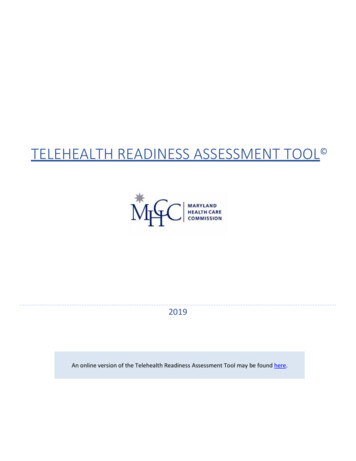
Transcription
TELEHEALTH READINESS ASSESSMENT TOOL 2019An online version of the Telehealth Readiness Assessment Tool may be found here.
Andrew N. Pollak, MD, ChairmanProfessor and Chair, Department of OrthopaedicsUniversity of Maryland School of MedicineChief of Orthopaedics, University of Maryland Medical SystemMarcia BoyleFounderImmune Deficiency FoundationCandice A. Peters, MDPhysical Medicine and Rehabilitation inPrivate PracticeMartin L. “Chip” Doordan, MHARetired Chief Executive OfficerAnne Arundel Medical CenterMartha G. Rymer, CPARymer & Associates, PAElizabeth A. Hafey, Esq.LitigatorBaltimore, MarylandRandolph S. Sergent, Esq.Vice Chair, Maryland Health Care CommissionVice President and Deputy General CounselCareFirst BlueCross BlueShieldMargaret Hammersla, PhDSenior Director DNP ProgramAssistant ProfessorOrganizational Systems Adult HealthUniversity of Maryland School of NursingStephen B. Thomas, PhDProfessor of Health Services AdministrationSchool of Public HealthDirector, Maryland Center for Health EquityUniversity of Maryland, College ParkJason C. McCarthy, Pharm.DVice President of Operations – BaltimoreKaiser Foundation Health PlanCassandra TomarchioBusiness Operations ManagerEnterprise Information Systems DirectorateUS Army Communications ElectronicsCommandJeffrey Metz, MBA, LNHAPresident and AdministratorEgle Nursing and Rehab CenterGerard S. O’Connor, MDGeneral Surgeon in Private PracticeMichael J. O’Grady, PhDPrincipal, Health Policy LLC, andSenior Fellow, National Opinion Research Ctr(NORC) at the University of ChicagoMarcus L. Wang, Esq.Co-Founder, President and General ManagerZytoGen Global Genetics Institute
Table of ContentsIntroduction .1Instructions .1Questionnaire .21. Core Readiness . 31.1 Need for Telehealth 31.2 Organizational Leadership Buy-in 42. Financial Considerations .53. Operations .63.1 Telehealth Roles 63.2 Scheduling and Workflow 73.3 Operational Requirements .83.4 Assessment Approach 93.5 Technology 93.6 Physical Space .104. Staff Engagement . .104.1 Education and Awareness 104.2 Innovators/Champions .115. Patient Readiness .125.1 Patient Engagement 125.2 Health Literacy 13TRA Tool Scoring 14Supporting Guidance . .16Core Readiness: Need for Telehealth 17Core Readiness: Organizational Leadership Buy-in .22Financial Considerations .25Operations: Telehealth Roles .30Operations: Scheduling and Workflow 33Operations: Operational Requirements .37Operations: Assessment Approach 42Operations: Technical Infrastructure 46Operations: Physical Space .51Staff Engagement: Education and Awareness 54Staff Engagement: Innovators and Champions .59Patient Readiness: Patient Engagement and Health Literacy 62Telehealth Resources .69About the TRA Tool .70About the MHCC 70
Telehealth Readiness Assessment ToolkitTELEHEALTH READINESS ASSESSMENT TOOLINTRODUCTIONTelehealth is the use of medical information shared through two-way audio and video and other forms oftelecommunication technology, including mobile communication devices and remote monitoring devices,with the goal of improving a patient’s health status. Telehealth can improve access to health care,increase delivery options and improve patient outcomes. However, implementation of telehealth servicesrequires organizations to shift how they operate and deliver care as organizational processes are often setup to support face-to-face encounters. For many small physician practices, challenges to successfullyimplementing a telehealth program may make the decision to provide telehealth services difficult.Challenges can include ensuring physician licensing for practitioners, credentialing for telehealth services,a lack of information about the return on investment, technology challenges.This Telehealth Readiness Assessment (TRA) tool is designed to assist small physician practices indetermining their readiness for telehealth. Practices can use the TRA tool to assess their level of readinessfor offering telehealth services, identify areas that need improvement, and prioritize improvement areasby importance. Results from the TRA tool are intended to help inform practices about provider, patient,caregiver, and organizational readiness for telehealth. Supporting guidance documents serve asreferences that provide more information and resources for helping practices prepare for telehealth.The TRA tool is intended to be completed in around 20 minutes by the lead physician or office manager incollaboration with other stakeholders in their practice.INSTRUCTIONSThis tool includes a questionnaire, scoring sheet, supporting guidance, and additional resources. As youprogress through the TRA tool questionnaire, select the option that most accurately reflects the actionsthat you or your practice have taken or considered in preparation for telehealth implementation.Scores are provided (web) or can be calculated (paper) for each concept organized into five key domains.Scores indicate if a practice is in the beginning stages or has not yet considered aspects related to theconcept (Low), has considered some aspects but shows need for some improvement (Moderate), or hasconsidered many aspects and is in the more advanced stages of readiness (High). Your overall readinessscore is a weighted average of the concept scores included within each of the five domains.The five key domains provided in the TRA tool are associated with successful implementation of telehealthbased on the literature.1. Core Readiness. To what extent has your practice considered the need for telehealth, the benefits oftelehealth and the challenges associated with implementing it?2. Financial Considerations. Does your practice have realistic expectations for the financialimplementations of telehealth including initial costs, sustainability, liability insurance, andreimbursement procedures?3. Operations. Has the practice considered how telehealth will impact operations and is the practice ableand willing to make appropriate changes?1
Telehealth Readiness Assessment Toolkit4. Staff Engagement. Is the practice team interested and engaged in implementing telehealth?5. Patient Readiness. Are practice patients ready for and interested in telehealth?Supporting guidance documents are provided with each concept to provide additional information thatcan help you improve your practice’s telehealth readiness in a particular area. The Telehealth Resourcesdocument provides links to general telehealth resources, organizations that offer information on privacyand security, and organizations that provide information about evaluation and assessment.Together, the TRA tool content is meant to provide you with useful guidance on assessing and improvingyour practice’s readiness to offer telehealth services.Description of Readiness LevelsLow Readiness: 50% – The practice is in the beginning stages and/or has not considered many of theaspects related to the concept or domain and would benefit from reviewing the associated SupportingGuidance document(s) and taking appropriate action.Moderate Readiness: 50% and 75% – The practice has considered some aspects related to theconcept or domain and should review the associated Supporting Guidance document(s) to identify areasfor improvement.High Readiness: 75% – The practice has considered many aspects related to the concept or domain.The Supporting Guidance is available as a resource for areas in which the scoring is lower.TELEHEALTH READINESS ASSESSMENT QUESTIONNAIREHOW DOES/WILL YOUR PRACTICE USE TELEHEALTH?Small physician practices can use telehealth in a variety of ways. For example, primary care physiciansmay use telehealth to provide their patients with access to off-site specialists. Providers may usetelehealth to offer counseling or follow-up services to patients located in their home or office.As you complete this tool, please think about how your practice uses or is considering telehealth services.USECASEWhere will patients be located during telehealth visits? Select all that apply. At one of our practice locationsOff-site: At another clinical location (clinic, practice, hospital)Off-site: Patient’s home or work2
Telehealth Readiness Assessment Toolkit1.3CORE READINESS1.1. NEED FOR TELEHEALTHConsider your practice’s needs with respect to telehealth.No/Unsure Somewhat(Please check one box in each row) a. Do patients in your practice have difficultygetting the medical care they need becauseproviders are too far away, patients lacktransportation, or patients are unable to leavework or home?b. Has your organization identified specific typesof patients or clinical needs that may benefitfrom using telehealth?c. Do patients in your practice ask for telehealthservices or express interest in aspects oftelehealth such as remote visits?d. Do patients in your practice use or express aneed or desire for after-hours (evenings andweekends) medical care?e. Do providers affiliated with your practiceroutinely travel over 30 minutes from theirprimary location to provide services in otherlocations?f. Do the potential benefits of telehealth for yourpractice outweigh the potential challengesassociated with telehealth?Your Score: Definitely 123123123123123123NotApplicable
Telehealth Readiness Assessment Toolkit41.2. ORGANIZATIONAL LEADERSHIP BUY-INConsider whether your practice has support and direction from leadership.No/Unsure(Please check one box in each row) a. Is your practice’s leadership committed totelehealth development efforts?b. Has your practice identified the vision, priorities,and goals for implementing telehealth?c. Has your practice created a telehealth businessplan?d. Has your practice’s leadership had past successeswith instituting programs that required complexchange processes, such as quality improvementinitiatives or electronic health recordimplementations?Your Score:Partially Fully 123123123123NotApplicable
Telehealth Readiness Assessment Toolkit52. FINANCIAL CONSIDERATIONSConsider the financial implications of telehealth, including costs and reimbursement, for yourpractice.No/Unsure(Please check one box in each row) a. Has your practice considered how it will fundany capital costs (e.g., equipment, software,licensing) needed to start a telehealthprogram?b. Has your practice identified what additionalstaffing costs, if any, are needed to implementand maintain a telehealth program?c. Has your practice examined the telehealthservices reimbursement policies for majorinsurers (Medicare/Medicaid, and privateinsurance)?d. Has your practice considered whether it wouldbe financially feasible to offer telehealthservices that are reimbursed by some but notall insurers?e. Has your practice gathered the necessaryinformation to conduct a cost, benefit, and riskanalysis of implementing and using telehealth?Your Score:Partially Fully 123123123123123NotApplicable
Telehealth Readiness Assessment Toolkit63. OPERATIONS3.1. TELEHEALTH ROLESConsider the roles and responsibilities needed for telehealth.No/Unsure(Please check one box in each row) a. Has your practice determined the staffresponsibilities required to manage theadministrative aspects of telehealth such asappointment scheduling, coordinatinginformation across providers, and patientdocumentation?Partially Fully 123123c. Has your practice determined what, if any,additional telehealth staffing support isneeded to implement and maintain atelehealth program?123d. Has your practice determined how to protectstaff time that needs to be dedicated to theirtelehealth roles and responsibilities?123b. Has your practice determined the staffresponsibilities required to support telehealthpatients, such as having a dedicated telehealthcontact person to explain telehealth, answerpatient questions, and provide assistance duringtelehealth appointments?Your Score:NotApplicable
Telehealth Readiness Assessment Toolkit73.2. SCHEDULING AND WORKFLOWConsider how your practice will schedule telehealth visits and what the associated workflow willbe for the visits.No/Unsure(Please check one box in each row) a. Has your p
Telehealth Readiness Assessment Toolkit 1 TELEHEALTH READINESS ASSESSMENT TOOL Telehealth is the use of medical information shared through two-way audio and video and other forms of telecommunication technology, including mobile communication devices and remote monitoring devices, with the goal of improving a patient’s health status .
